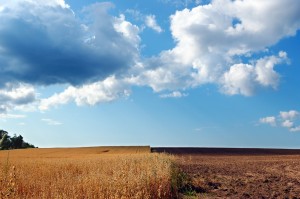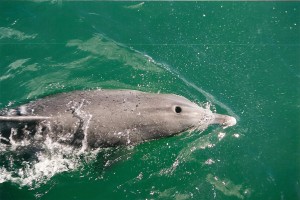Worldlog Semana 43 – 2013
El 16 de octubre fue el Día Mundial de la Alimentación. 57 Días después de Earth Overshoot Day, el día en que este año sobrepasamos la capacidad reproductiva de la tierra y logramos un nuevo déficit ecológico de gran volumen. El 16 de octubre hubo mil millones de personas se acuestan con hambre. No porque no hay suficiente alimentos son producidos. La tierra tiene suficiente para las necesidades de todos. Pero además de los mil millones de hambrientos son mil millones de personas que tienen sobrepeso.

Nos enfrentamos a una distribución muy desigual de los alimentos a través de la explotación que aun en nuestra generación va a llegar a una grave escasez entre otras cosas de agua potable, fosfato y biodiversidad. También hay que tener en cuenta la escasez de alimentos para animales causada por la pérdida de cosechas debido a nuestra negligencia en relación con el clima.
Una investigación realizada por la Universidad de Minnesota el mes pasado comprueba que hay una esperanza para la población mundial en crecimiento, siempre y cuando la política se cambie sustancialmente. Podríamos con la superficie de cultivo actual alimentar a más de 10 millares de personas, siempre que no perdamos los cultivos en alimentos y biocombustibles.
El sector ganadero cubre mundialmente un 80% de todas las tierras agrícolas. El consumo excesivo de la proteína animal y su producción excesiva no sólo causa un exceso de obesidad y un sufrimiento de los animales aquí, sino también causa hambre y destrucción en el resto del mundo. Todavía se sigue talando a gran escala partes del bosque tropical lluvioso destinado al cultivo en masa para la alimentación animal. La producción de carne es, pues, responsable del 30% de pérdida de biodiversidad mundial.
Un estudio sobre el futuro de la ganadería holandesa indica que nuestro estilo de vida requiere cuatro Tierras cuando el resto del mundo retoma nuestra forma de consumir. Las apuestas en una agrícola ‘sana’, cerca de la casa, podrán cerrar nuevamente los ciclos de los productos básicos, disminuir nuestra dependencia alimenticia y ofrecer al mundo un ejemplo duradero. Una agricultura verdaderamente sostenible restablece la conexión entre consumidores y productores de alimentos, y asegura de que los agricultores reciban un precio justo por un producto justo.
El gobierno tendrá que estimular los Países Bajos para considerar al cuchillo y el tenedor como el arma principal en la lucha contra el cambio climático, la biodiversidad y el sufrimiento de los animales.
En mi Worldlog de la semana 40 hablé sobre nuestro éxito de poner fin a los masacres de delfines en las Islas Feroe. Esta semana también recibimos una buena noticia para los delfines en Japón. Nuestra moción, que llama al Gobierno holandés a poner un fin a forma internacional a la masacre de masa anual de delfines en Taiji (Japón), ha sido aceptada!
Cada año en Taiji (y las Islas Feroe) miles de delfines salvajes son juntados a fuerza. Bárbaramente los animales son matados culminando en una gran masacre. Japón tiene una gran participación en esta caza de unidad, para poder vender a precio alto a los delfines a los acuarios, a los acuarios marinos y los programas turísticos para nadar con estos animales. Los demás delfines – unos 23.000 delfines al año – son sacrificados por su carne.

La caza comercial de ballenas es ilegal, pero los pequeños cetáceos, como los delfines, aún no están incluidos en el programa de protección de la Comisión Ballenera Internacional (CBI). Gracias a nuestra moción aceptada el gobierno se ha comprometido a ampliar el régimen de protección de la CBI, por lo que también la caza de cetáceos pequeños puede ser atacado.
Haz clic aquí para el nuevo tráiler de the Blackfish. Queremos recomendar esta película!
Y vean aquí o lean aquí sobre la acción maravillosa del artista Banksy: Sirens of the Lambs!
Hasta la semana entrante!
Marianne
On 16 October it was World Food Day. 57 Days after Earth Overshoot Day, the day on which we exceeded the reproductive capacity of the earth this year and hit a new record ecological budget deficit. On 16 October one billion people went to bed with hunger. People are not hungry because too little food is produced. The earth offers enough for everyone’s needs. But next to those one billion hungry people are one billion people who suffer overweight.

We contend with a distorted division of food and forms of exhaustion, which, in our generation, will lead to scarcity of drinking water, phosphate and biodiversity among other things. Furthermore, we have to watch out for a possible shortage of cattle food due to poor harvests as a result of the neglect of our climate.
Research of the University of Minnesota showed us last month that there is definitely hope for a growing world population, on the condition that the policy will be substantially changed. With the current arable farming area we should be able to feed more than 10 billion people, provided that we do not waste harvests on cattle food and biofuel.
Cattle farming on a global basis takes up 80% of all agricultural lands. The excessive animal protein consumption and production do not only cause serious overweight and animal suffering here, but also hunger and destruction in the rest of the world. The tropical rain forest is still cut down on a large scale for the massive production of cattle food. As a result, the production of meat is accountable for 30% of the global biodiversity loss.
A study into the future of Dutch animal husbandry indicates that we would need four globes to fit our lifestyle when the rest of the world takes over our consumption pattern. Aiming for healthy agriculture, close to home, may close the raw materials cycle again, reduce our food dependency and give the world an example of good sustainability. A true sustainable agriculture will repair the connection between the consumer and the food producer and will ensure that farmers get a fair price for a fair product.
The government will have to encourage the Netherlands to consider knife and fork as the most important weapons in the fight against climate change, biodiversity loss and animal suffering.
In my Worldlog of week 40 I told you about the successful stopping of dolphin slaughter on the Faroe Islands. This week we also have some good news for the dolphins in Japan. Our motion, which calls the Dutch government to advocate internationally for an end to the annual mass slaughter of dolphins at Taiji (Japan), was adopted!
Each year thousands of wild dolphins are driven together at Taiji (and the Faro Islands). The animals are killed in a barbaric way, resulting in one big bloodbath. Japan has a great share in these drives, so that they can sell wild dolphins for a lot of money to dolphinariums, sea aquariums and touristic programmes for swimming with these animals. The other dolphins, approx. 23,000 dolphins per year, are slaughtered for their meat.

Commercial hunting of whales is illegal, but small cetaceans, including dolphins, have still not been included in the protection programme of the International Whale Commission (IWC). Thanks to our adopted motion the government now has to aim at expansion of the protection regime of the IWC, so that the hunting of small cetaceans can also be tackled.
Click here for the trailer of the new film of the Blackfish. This film is highly recommended!
And look here or read here about the wonderful action of artist Banksy: Sirens of the Lambs!
Until next week!